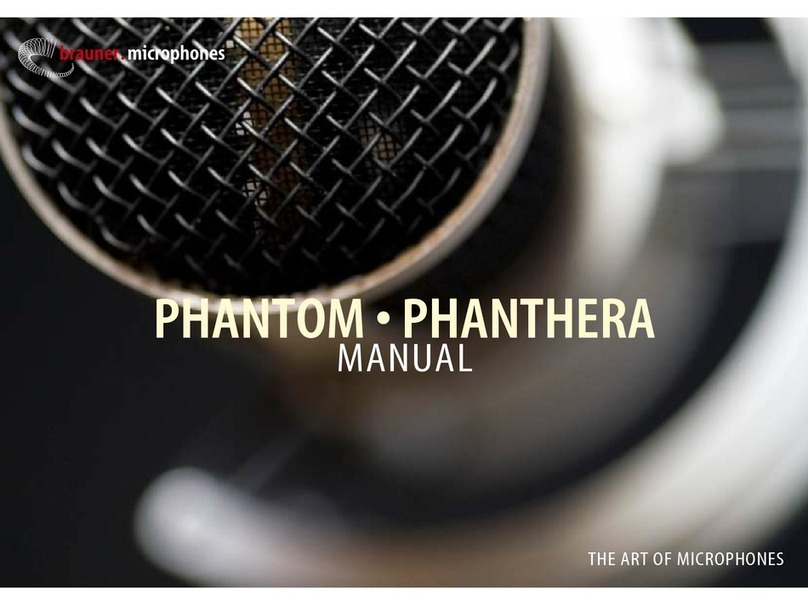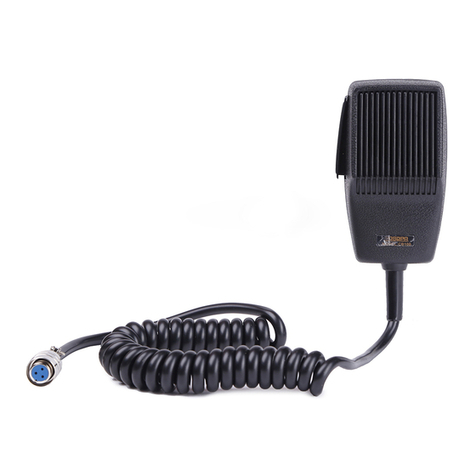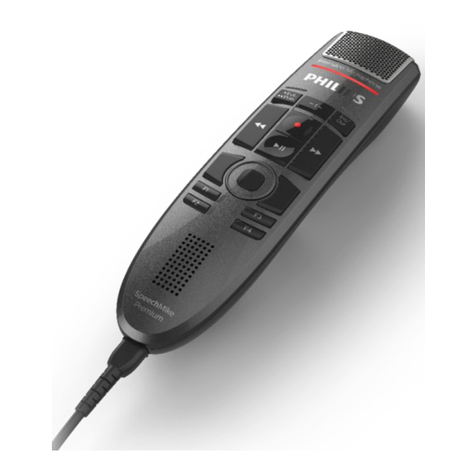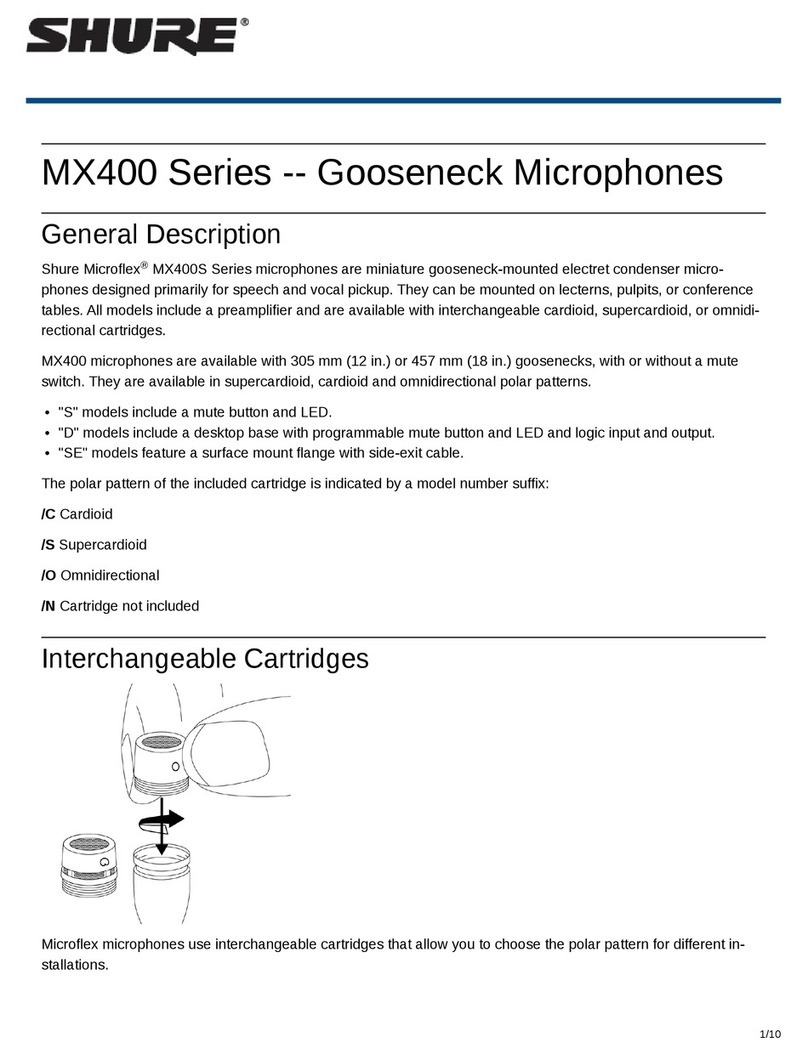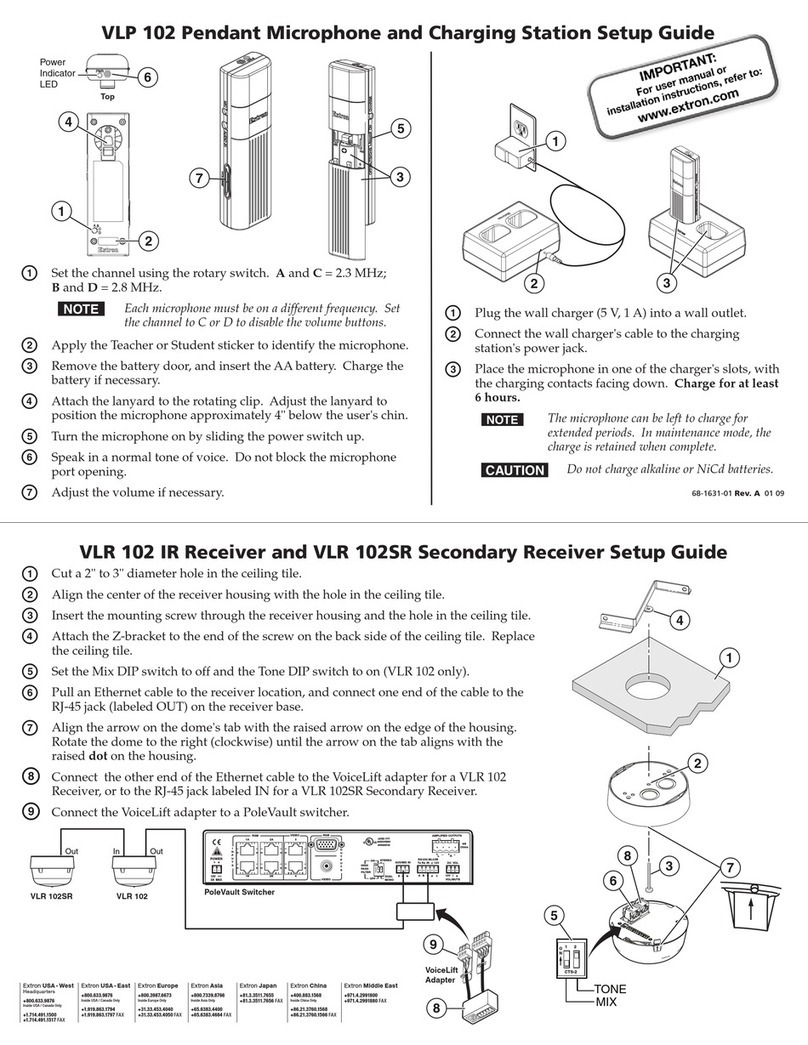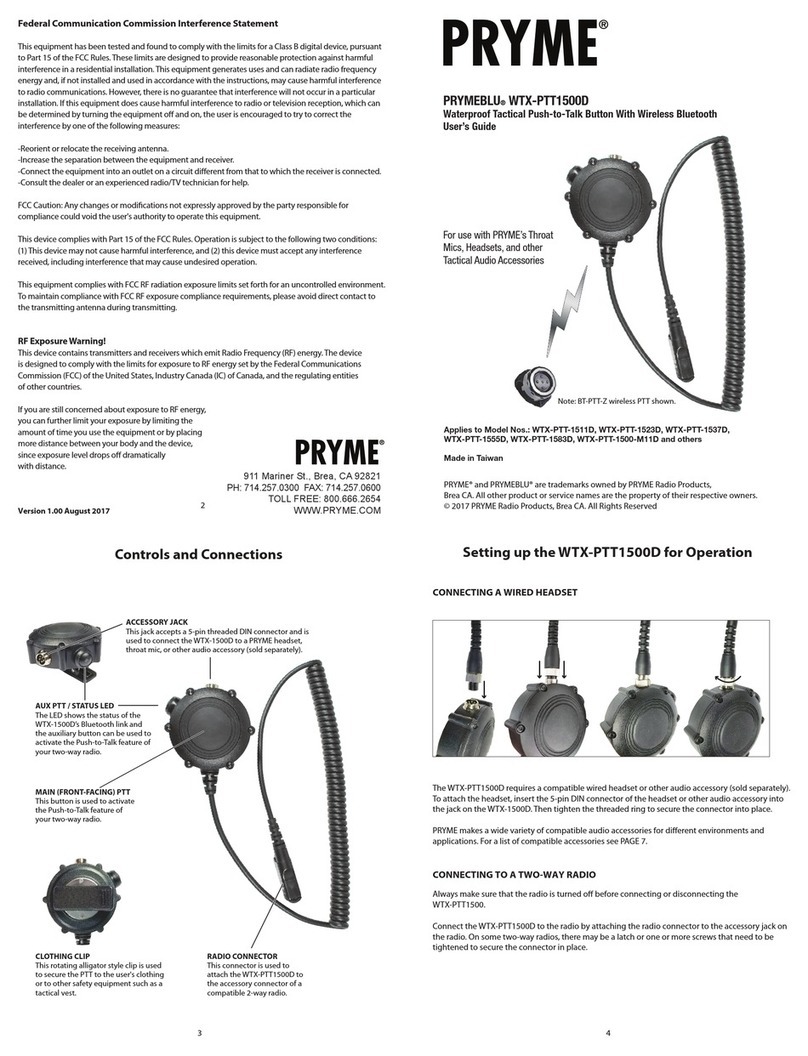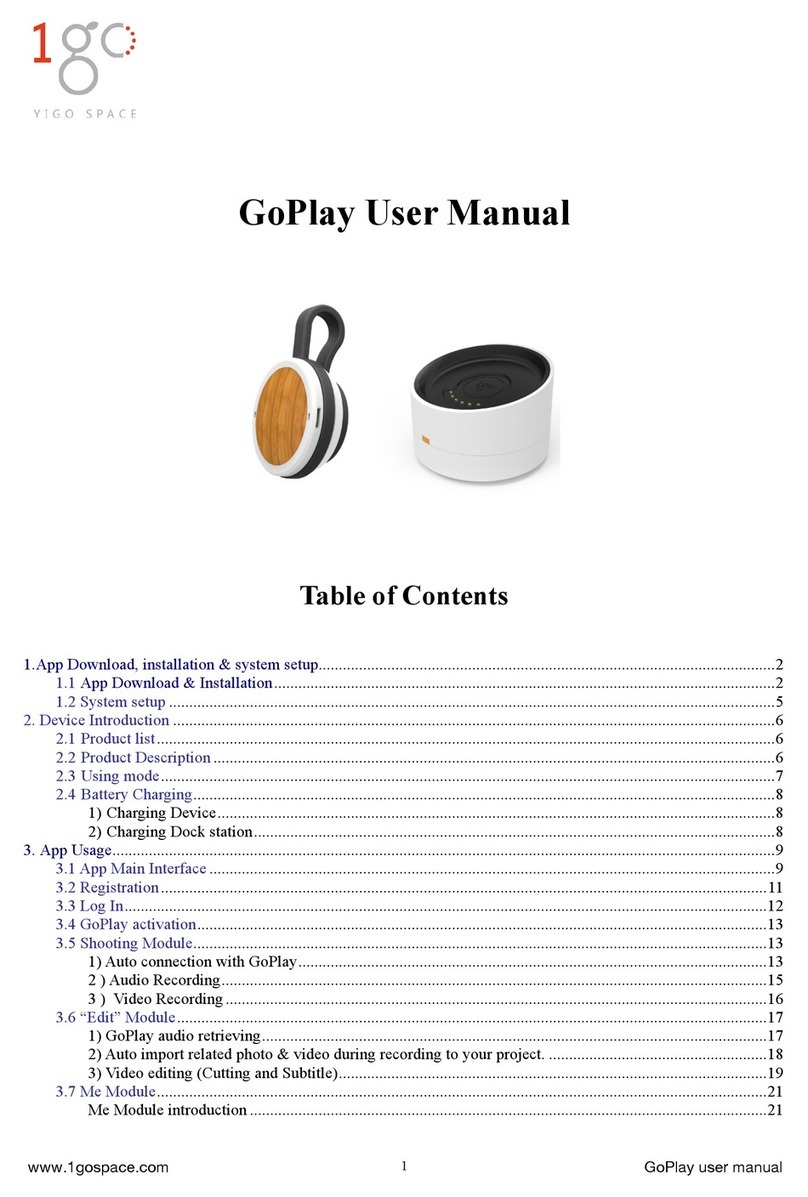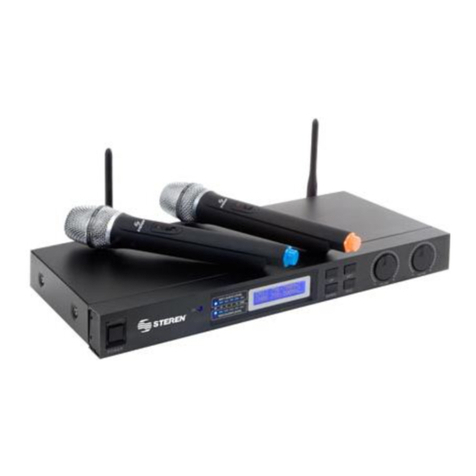Brauner VM1S User manual

MANUAL
VM1S
THE ART OF MICROPHONES

Brauner Microphones
Rudolf-Diesel-Str. 11
D-46459 Rees
Germany
Tel.: +49 (0)2851 588 98 68
Fax: +49 (0)2851 588 98 67
www.brauner-microphones.com

1.0
1.1
2.0
2.1
2.2
2.3
2.4
2.5
3.0
3.1
3.2
3.3
3.4
4.0
5.0
6.0
1.0 Table of Contents
Tabe of Contents
Introduction
Safety Instructions
Setting Up
Aluminum Case
Suspension
Inserting the Microphone
Connections
Power Supply (Remote Control)
Pattern Control
Power Supply Back Panel
Ground Lift Switch
Adjusting The Voltage Selector/Changing Fuses
Maintenance and Care
Technical Specications
Warranty Regulations
3
4
5
6
6
6
7
7
8
8
9
9
9
10
11
12
3

Thank you for purchasing this original Brauner microphone and
thus supporting a part of the world famous German craftmenship
and our love for quality, detail, precision and persisting values. Our
microphones go to the full extent of what is physically possible to-
day to achieve unparalleled results.
To reach this high level of perfection only best components are
carefully selected, assembled and calibrated to become these won-
derful works of art and sound. Even though this is a time-consu-
ming and costly process, it ensures the quality of our microphones
in a way industrial mass production could never do. As our goal is
to oer the best micophones money can buy, we will not make any
compromises for the sake of our products‘ quality. Thus a Brauner
microphone is not only a professional and reliable tool for your daily
work but also a lifetime investment.
According to our company‘s philosophy we try to think of sound re-
cording as an art rather than a technical method. For this reason we
build and develope our microphones not just as pure technical but
also artistic tools. Of course, one emphasis of our work is reaching
the best physical limits (e.g. extremely low self noise, highest pos-
sible dynamic range and proper impulse response), but the most
important, as we believe, is the sound.
As „sound“ cannot be entirely evaluated with audio measurement
capabilities given today, a very important part of building our
microphones is a severe listening test. Not one microphone will
leave our factory unless it has passed tests by the critical and un-
forgiving ears of our engineers who do not tolerate the smallest
deviation from our high standards.
This approach has created the enormous reputation and esteem
Brauner products have become famous for. A reputation we feel
deeply committed to.
We would like to wish you success and enjoyment with your new
microphone into which we have put all our experience and know-
ledge and which will surely accompany you during your work for
many, many years.
The VM1 was the fulllment of Dirk Brauner’s dream to build his vi-
sion of the perfect sounding tube microphone. A microphone that
captures the spirit of the classic vintage tube microphones and at
the same time, meets the high technical standards of today’s mo-
dern microphones.
The VM1S is the stereo version of the VM1. It is currently, without
doubt, the most intricate of all Brauner microphones. It unites two
identical VM1 microphones, precisely matched to each other, in a
single housing. It is a design that answers every wish of a stereo
microphone.
1.1 Introduction
4

Tube equipment runs on fairly high voltages that can be lethal in case of direct con-
tact. Brauner products comply to all international safety regulations, are tested severe-
ly and can therefore be used safely and without any risks if the following regulations
are met:
1) Please read this manual carefully.
2) The manufacturer will in no way be able to be held responsible for damages of
any kind whatsoever if these occur from unintended use of the equipment or occur
from any changes to the equipment made by someone not explicitly authorized by
the manufacturer.
3) Do not open the equipment if not told to by our service personnel. Always dis-
connect the mains if you should open it (HIGH VOLTAGE!). Unauthorized opening
will void your warranty. Only authorized service personnel is allowed to repair this
equipment.
4) The equipment contains high voltage capacitors that charge voltages up to 230V
even when it is switched o and disconnected from the mains. Internal resistors will
discharge the capacitors within about 10 minutes after disconnecting.
5) The equipment must be grounded. Never disconnect or bypass the safety ground
from your power supply.
6) Check the voltage settings of the power supply before turning it on. Exchange
fuses only with the same type (at 115V mains voltage: 800mA/230V time lag, accor-
ding to DIN 41662).
7) Take good care of your cables. Check them for damages regularly and replace them
if damaged. Don‘t work with damaged cables.
8) Avoid the use of the equipment under extreme conditions such as dust or high
humidity. Do not throw away the desiccant bag but keep it in the case close to your
microphone. It is lled with non toxic, activated clay which has an excellent long term
stability and a very high absorption potential for humidity.
9) Avoid dropping or punching the equipment. Always store it in the transport case if
not used. If the equipment is dropped or damaged in any way, disconnect it from the
mains, wait for 15 minutes and then check it for visible damages or loose parts and
get in touch with our service team.
10) Be sure to use a microphone stand that can support the weight of the micro-
phone.
2.0 Safety Instructions
5

Experienced users:
If you already have experiences with tube microphones, setting up and working with
this Brauner microphone shouldn‘t be a problem to you. Mount the suspension on a
stand, insert the microphone and connect the cables. If you‘re not used to the Brauner
microphone suspension read the according chapter in this manual.
New users:
If this is your rst Brauner tube microphone, please read this manual carefully. It con-
tains many valuable hints that might save you a lot of time and help you to handle this
microphone and get the best results in daily use.
All Brauner microphones and their accessories come in a sturdy aluminum case that
provides eective protection. When not used you should always store your micro-
phone in this case.
Power and microphone cables are stored in the case‘s top compartment behind the
lid. Try to store your cables exactly like they were shipped to avoid any damages as the
quality of your signal chain depends on its weakest link.
In the bottom compartment you will nd the microphone, the suspension, and the
power supply which also acts as a remote control for the microphone.
The provided microphone suspension was designed to ensure a good acoustic de-
coupling and positioning of the microphone. In the suspension the microphone can
be rotated 360° horizontally and 180° vertically. It might take a little while to get used
to how the suspension works but then re-positioning the microphone will be a quick
and easy task for you.
First attach the suspension to a suitable microphone stand, then loosen the lever on
the back of the suspension and position it so that the Brauner logo on the front is
facing your way. Now tighten the lever again. You can always adjust the lever‘s arm
to another position by simply pulling it upwards and positioning it again without
loosening its tension as it is a wingnut.
It is very popular to install the microphone in an over-
head position with it facing down and thus giving the
singer or speaker the possibility to look at music or
lyric sheets.
Using the microphone on a table, it should always
face up to avoid picking up reections from the table‘s
surface.
2.1 Setting Up
2.2 Aluminum Case
2.3 Suspension
6

Before connecting any cables make sure there are no damages and the power is tur-
ned o. At rst connect the microphone and its power supply with the 12 pin Tuchel
cable and tighten the screws. This avoids hum or interference problems.
Once again check if the power supply is set to the right voltage of your environment
and then connect the power cable. At last connect the signal output on the back of
the power supply with your mixing console‘s or microphone preamp‘s input.
You are now all set to power up the microphone. As it is using a tube it will need some
time before you hear a rst signal (15s). You should let it warm up about 15 minutes
for the microphone to properly acclimate and evolve its sound.
Before inserting the microphone into the suspension you should have a look at the
two black collar rings on each end of the suspension‘s inner cylinder. These rings can
be turned 360° and the little white dots should align with the black screws on the
cylinder to be in the open position (see picture).
Now insert the microphone into the suspension with the bottom rst. To help you
align the microphone there is a black dot right below the grill showing the 0° angle
in the polar diagram.
While holding the microphone with one hand, tighten the black collar rings. Looking
at the front of the suspension, the upper black ring should be turned to the right, the
lower one to the left. You should turn the rings until the microphone is tight and safe
in the desired position, but never overwind them.
If you should have the feeling that the microphone is askew in the suspension, you‘ve
probably turned the rings in the wrong direction.
2.4 Inserting The Microphone
2.5 Connections
7
Sollten Sie das Gefühl
haben, dass das Mikrofon
schief in der Spinne steht,
so haben Sie wahrschein-
lich die beiden Klemm-
ringe in die genau falsche
Richtung festgedreht.

With the continuously variable pattern control you have full control of the
microphone‘s directivity changing it to whatever is best for your very purpose. I.e., in
an MS conguration you will be able to inuence the mid signal very eciently.
It is even possible to change the directivity during a recording (without any inter-
ferences or noise). It will take about 15 seconds for the directivity to fully transform if
you turn the knob a whole step (from one symbol to the next) as capacitors have to
be charged and discharged. If you only make a little adjustment the pattern adapts
much faster.
The power supply is built as a module to t into any 19 inch studio rack next to pre-
amps and eects or to be used as a stand alone device. It contains two seperated
supplies for each mircophone. Thereby the VM1S can be used as a single microphone
and in stereo mode the highest possible crosstalk rejection is achievied.
It also serves as a remote control unit for the microphone providing you with an ad-
justment wheel for its directional pattern. Moreover there a the two power switches
on the front panel. As the microphones have an excellent phase and frequency re-
sponse there are no integrated lters.
For new users we would like to oer a short description of every pattern and its advantages:
Omni
In omni characteristic the microphone will pick up sonic information about equally from eve-
ry direction. This pattern is perfect for making ambience recordings which are often mixed
with an orchestra or movie recording to give it more space. Two microphones in omni pattern
are a great set up for stereo recordings.
Cardioid
The cardioid pattern is probably used most often with the microphone having its greatest
sensitivity for sound coming from the front. Sound from the sides (90° and 270°) is reduced by
half and sound from the back (180°) to a tenth. It‘s often used for vocals or single instruments
without picking up to much of the room.
Figure of eight
In this pattern the sensitivity for sound coming from the back and the front is equal, but infor-
mation coming from the sides is cancelled out. This is due to the back side diaphragm being
phase reversed to the the front side diaphragm. Main application of the gure of eight pattern
are stereo recordings such as the MS or XY technique which require an MS matrix decoder to
achieve a proper stereo signal. The stereo version of the VM1, the VM1S, is best suited for this
kind of recordings.
Wide cardioid
The wide cardioid pattern lies between cardioid and omni. In comparison to cardioid it has
greater sensitivity for sound coming from the sides and lets recordings gain more ambience
elements without emphasising them too much (like omni).
Hypercardioid
Hypercardioid lies between cardioid and gure of eight. In comparison to cardioid sensitivity
for sound from the sides is less but greater for sound from the back. Thus hypercardioid is
even more directional to the front and is for example used to record brass section or drums to
achieve a good separation between single instruments.
3.0 Power Supply (Remote Control)
3.1 Pattern Control
8

The ground lift switch detaches the ground pin (pin 1) of the XLR output from ground
and can be set to three positions. Safety earth is never detached of course. Use the
switch to eliminate hum problems you might have.
Lower position: (H)ard-ground: The ground pin is conductively connected to the
ground center of the internal circuit.
Mid position: Ground-(L)ift: The ground pin is completely disconnected from ground.
Upper position: (S)oft-Ground: The ground pin is connected to the ground via a safety
capacitor that decouples the AC portion of the hum to the ground.
On the back panel of the power supply there are four connectors: power, microphone
(Tuchel connector) and the two signal outs (XLR phase signal on pin 2). Additionally
there is a ground lift switch for each XLR out and the voltage setting/fuse holder.
3.2 Power Supply Back Panel
3.3 Ground Lift Switch
Before operating the microphone at a new location always make sure the voltage is
set to the right value. It can be set to either 115V or 230V.
To change the setting, turn o the power supply and disconnect the power cable.
Take out the fuse holder which is right next to the power connector by squeezing
the little latch. On the back of the black fuse holder is a grey plug-in which you can
pull out, turn around and push back in again to switch the voltage setting. Make sure
the right voltage number can be seen in the little window on the other side of the
fuse holder. If you need to change fuses you can do so now before inserting the fuse
holder back into the power supply again.
We suggest that you always check the setting when you travel somewhere, or make a
note and stick it to the power supply if you have changed the setting. Fuses are cheap,
but usually not around when you need them.
Exchange fuses only with the same type (at 115V mains voltage: 800mA/230V time
lag, according to DIN 41662).
3.4 Adjusting The Voltage Selector/Changing Fuses
9

We take great care and attention when we manufacture our microphones. We only
use the highest quality components available, many of which are exclusively manu-
factured according to our specications and individual needs. All components must
pass our severe QC and selection processes without which the production of such a
delicate microphone would not be possible.
The material used for the diaphragm of our capsules is especially made for us and
withstands a wide moisture and temperature range and will show no aging eects
even after many years of operation.
Nevertheless you should regard some simple rules to maintain the longevity of your
microphone we have laid the foundations for:
1) Always store the microphone in its case when it‘s not being used for a longer peri-
od of time. Place the provided desiccant close to the microphone, especially in places
with high humidity.
2) Don‘t use the microphone under extreme environmental conditions. Try to avoid
dust and humidity.
3) Do not smoke when using the microphone. Cigarette smoke contains acids that
can harm the microphone‘s diaphragm and build up high resistance shortcuts which
can lead to a loss in signal quality and increased noise. Smoking is bad for you and
your microphone.
4) The suspension‘s black collar rings might leave black marks on the microphone
in the beginning. Use a damp cloth to remove them and treat the nickel surface of
the microphone with a mild acid free oil that you can put on very carefully using a
soft cloth and distribute thinly over the whole surface so there is no smear or nger-
prints.
Never use any aggressive detergents to clean the surface of your microphone or its
accessories. Never let any liquids get inside of your microphone or power supply.
5) The supplied VOVOX-TubeLink cable is custom made and of very high quality. Do
not bend or knot it in a sharp angle. Do not drop the Tuchel connectors to the ground.
Always wind the cable in big slopes and free of twists to avoid damages to the shiel-
ding or wire leads. The overall quality of your audio chain can only be as good as its
weakest part which often is the cable.
6) Avoid dropping the microphone or any inuence of force to it or its accessories. If it
is dropped or hit, power it o immediately and check for damages or loose parts and
contact our service team.
7) Always secure the microphone with one hand when inserting it into the suspen-
sion.
4.0 Maintenance and Care
10

Microphone Category:
Pattern:
Acoustical Principle:
Frequency Range:
Sensitivity:
Impedance:
Self Noise:
Signal to Noise:
Maximum SPL:
Included in Delivery:
5.0 Technical Specications
Tube Microphone
Any / Continuously Variable
Large Diaphragm Condenser Microphone
20 Hz to 22 kHz
28 mV/Pa @ 1 kHz @ 1m
200 Ohm
< 11 dB A (IEC 651)
> 83 dB A (1 Pa/1kHz cardioid)
142 dB SPL @ 0.3% THD
Microphone, Suspension, PSU/remote w/ Cable,
Stereo Microphone Cable 12.5m, Windscreen,
Manual, Aluminum Case
11

Limited warranty:
Brauner Microphones will provide warranty and service for this unit in accordance to
the following warrants:
Brauner Microphones warrants to the original purchaser that this product and the
components thereof will be free of defects in workmanship and material for a period
of 24 months from the date of purchase. Brauner Microphones will, without charge,
repair or replace, at its option, defective product or component parts upon prepaid
delivery to the factory service department or authorized service center, accompanied
by proof of purchase given in the form of a valid sales receipt.
Exclusions:
This warranty does not apply in the event of misuse or abuse of the product or as a
result of unauthorized alterations or repairs. This warranty is void if the warranty seal
is altered, defaced or removed.
Brauner Microphones reserves the right to make changes in design or make additions
to or improvements upon this product without any obligation to install the same on
products previously manufactured.
Brauner Microphones shall not be liable for any consequential damages, including
without limitation damages resulting from loss of use. For units purchased outside
the Federal Republic of Germany, an authorized distributor of Brauner Microphones
will provide service.
Service Address:
Brauner Microphones
Rudolf-Diesel-Str. 11
D-46459 Rees
Germany
Tel.: +49 (0)2851 588 98 68
Fax: +49 (0)2851 588 98 67
Email: info@brauner-microphones.com
Service: [email protected]
Internet: http://www.brauner-microphones.com
6.0 Warranty Regulations
12


Brauner Microphones
Rudolf-Diesel-Str. 11
D-46459 Rees
Germany
Tel.: +49 (0)2851 588 98 68
Fax: +49 (0)2851 588 98 67
www.brauner-microphones.com
Table of contents
Other Brauner Microphone manuals
Popular Microphone manuals by other brands

Monacor
Monacor img Stage Line HSE-150A/SK operating instructions

STUDIO PROJECTS
STUDIO PROJECTS B3 instruction manual
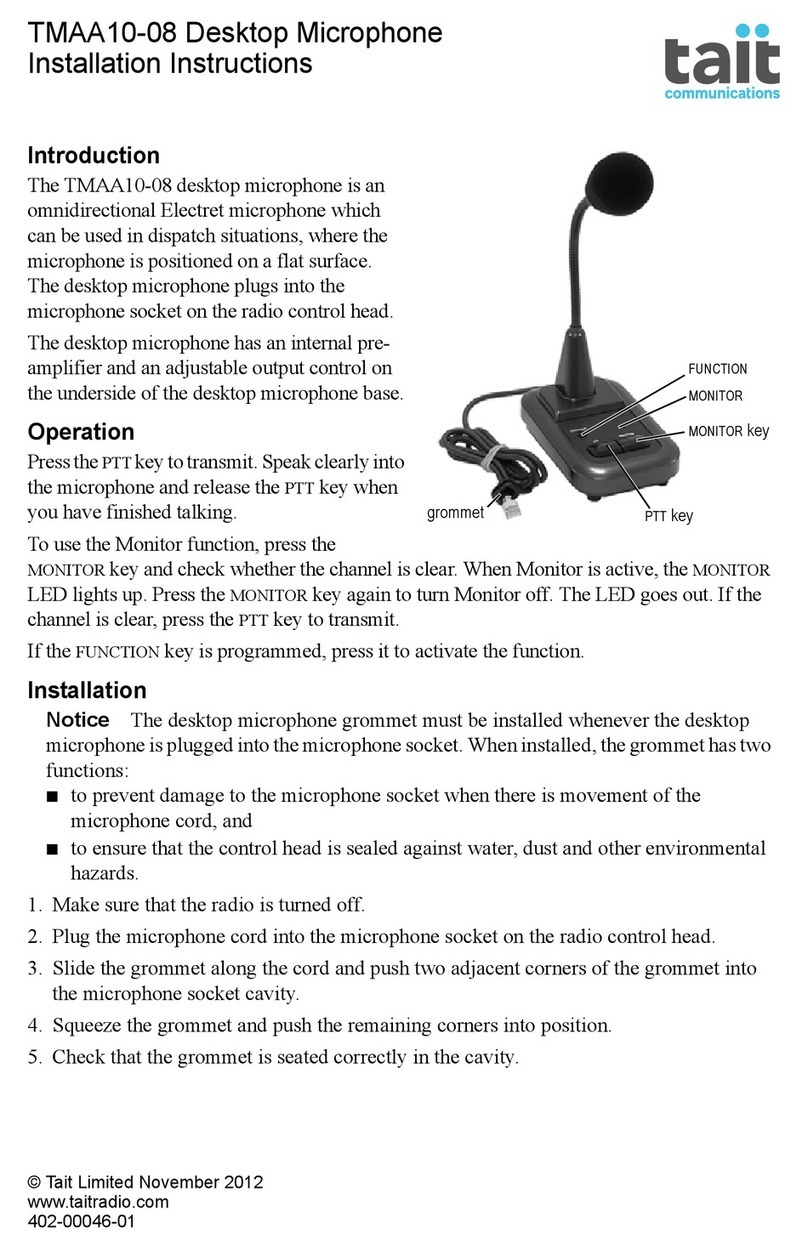
Tait
Tait TMAA10-08 installation instructions
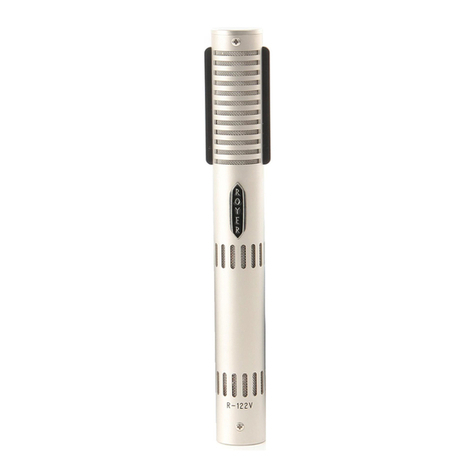
royer
royer R-122V Operation instructions manual & user guide
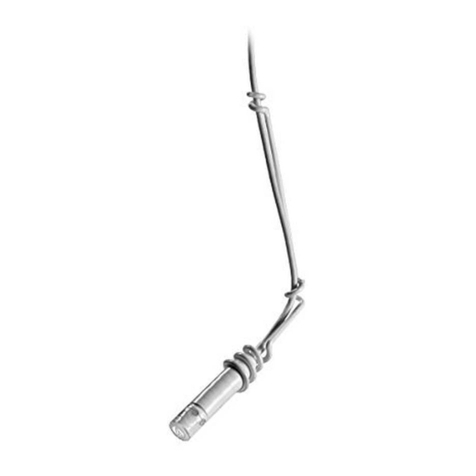
Audio Technica
Audio Technica PRO 45 Specifications
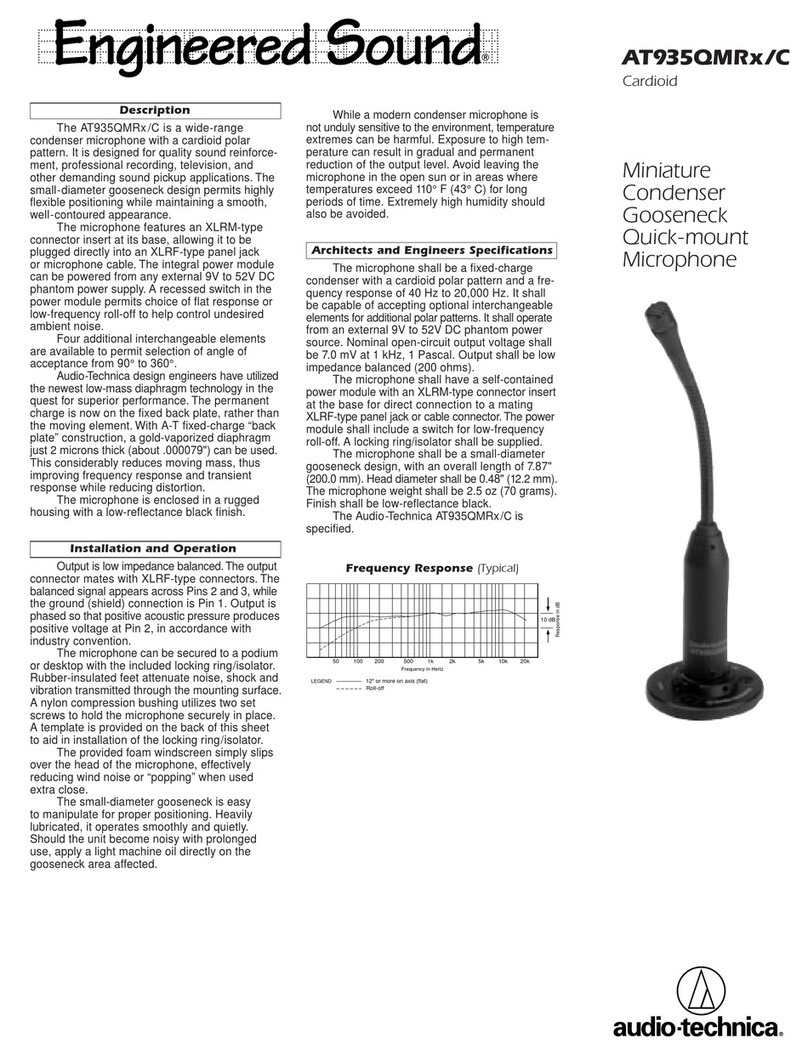
Audio Technica
Audio Technica AT935QMRx Product information

